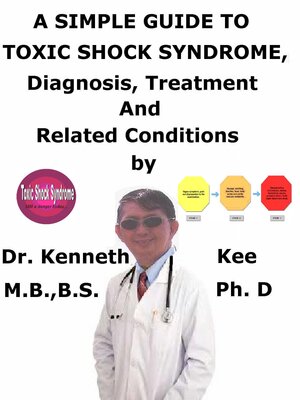A Simple Guide to Toxic Shock Syndrome, Diagnosis, Treatment and Related Conditions
ebook
By Kenneth Kee

Sign up to save your library
With an OverDrive account, you can save your favorite libraries for at-a-glance information about availability. Find out more about OverDrive accounts.
Find this title in Libby, the library reading app by OverDrive.



Search for a digital library with this title
Title found at these libraries:
| Library Name | Distance |
|---|---|
| Loading... |
This book describes Toxic Shock Syndrome, Diagnosis and Treatment and Related Diseases
Toxic Shock Syndrome has long been associated with women using highly absorbent tampons
After the removal of these tampons, the incidence of TSS linked with menstruation dropped to 50%
TSS can also happen in non-menstrual situations such as in soft tissue infections, surgical and postpartum wound infections, burns, skin lesions, retained foreign bodies, and dialysis catheters.
Recently I had a patient who developed necrotizing fasciitis of her right leg and had to be admitted to hospital for a surgical debridement and removal of the dead tissue.
She developed toxic shock syndrome in the hospital and had to be resuscitated back to life.
Toxic shock syndrome (TSS) is a rare but life-threatening bacterial infection that requires immediate medical attention.
Certain bacterial infections secrete toxins into the bloodstream which then passes the toxins to body organs and cause severe damage and illness.
It happens when the bacteria responsible such as Staphylococcus aureus and Streptococcus pyogenes (normally living harmlessly on the skin) or Clostridium sordellii (part of the normal flora of the vagina) invade the body's bloodstream and release poisonous toxins.
These toxins produce a sudden high fever and a massive fall in blood pressure (shock), leading to dizziness, vomiting and diarrhea and confusion.
The toxins also injure tissues such as skin and organs and can affect many vital organ functions.
Risk factors for toxic syndrome are:
Using super-absorbent tampons
Surgical wounds
Local infection in the skin or deep tissue
Using the diaphragm or contraceptive sponge
Recent childbirth, miscarriage or abortion
Any body can obtain toxic shock syndrome: men, women and children.
For reasons not understood, a significant percentage of cases happen in women who are having the menstrual period and using a tampon, particularly tampons designed to be 'super absorbent'.
The danger of toxic shock syndrome is higher in young people because many older people have already developed resistance (immunity) to the toxins secreted by the bacteria.
The presentation of TSS normally starts with a sudden high fever with body temperature rising above 38°C/100.4°F.
More symptoms then quickly appear normally in the course of a few hours such as:
Nausea and vomiting
Skin rash with shedding of the skin in large areas
Fainting from hypotension
Medical criteria for TSS involve fever, rash, hypotension and multi-system organ affliction.
The disorder is diagnosed by examination of the typical symptoms and evidence of organ failure.
Blood cultures are used to find and identify micro-organisms and their sensitivity to antibiotics.
The person needs to be admitted to hospital straight away and treated in an intensive care unit.
The treatment for TSS may involve:
Supplemental oxygen or mechanical ventilation to assist with breathing
Intravenous (through a vein) antibiotics
Intravenous fluid to treat shock and prevent organ damage
Giving blood products to relieve shock
Heart medicines in people with very low blood pressure
Dialysis may be needed in people who develop kidney failure
Deep surgical cleaning (debridement) of an infected wound
In some patients, immunoglobulin may also be given together with antibiotics.
If TSS is diagnosed and treated early with antibiotics, a high chance of recovery is possible.
If it is left untreated, the combination of shock and organ damage can result in death.
TABLE...







